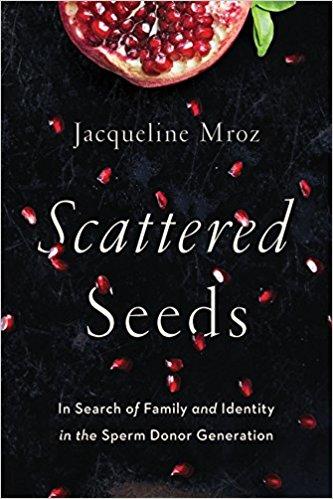"Scattered Seeds" makes the case for disclosure of sperm donors

Scattered Seeds: In Search of Family and Identity in the Sperm Donor Generation, by Jacqueline Mroz, 253 pp. Seal Press, 2017.
In 1681, the English poet John Dryden began his epic poem “Absalom and Achitophel,” a political satire, with an account of a monarch who:
…after Heaven’s own heart
His vigorous warmth did variously impart…
and, wide as his command,
Scattered his Maker’s image through the land.
This poetic analog would have made an apt epigraph for journalist Jacqueline Mroz’s Scattered Seeds. If we replace “monarch” with “worldwide fertility industry,” we see that in the last 50 years or more the industry has variously imparted the sperm of untold numbers of men to millions of offspring worldwide. Through the industry’s agency, particular men have scattered their image throughout the land.
One of the clearest examples is Donor B155A from Fairfax Cryobank in Virginia, who, has fathered an estimated 150 to 200 children through artificial insemination. On a broader scale, record keeping is so lax that no one knows precisely how many babies have been born as a result of artificial insemination with sperm from “donors,” who are compensated for their biological material.
There is also little, if any, information about how many of the resulting offspring have been informed by their parent or parents about their origins. Clinics generally know how many children individual sperm donors have spawned, but they do not readily share that information with past or future clients, and have no responsibility to report it to any oversight body, government or otherwise. While some clinics have provisions that allow the release of information about a donor to offspring (often at age 18), many operate on the notion that anonymity offers the greatest legal and emotional protection to donors. Only a handful operate with open registries that allow recipients and offspring access to donor information.
In Scattered Seeds, Mroz tracks the rise of client pushback over recent decades. She begins with the founding of the Donor Sibling Registry in 2000 by Wendy Kramer, who realized that if her son, Ryan, had a burning curiosity about his biological progenitor, so too must other children.
Kramer’s website and others like it have likely enabled thousands of donor children to connect with one another. Half-siblings have met each other online and in person, as have parents who have had children from the same sperm donor. In some cases, the site has led to donors meeting one or more of their offspring and to extended family members, related only through the donor, to meet one another.
Through dozens of interviews, Mroz gives us insight into how these new biologically-joined families, bred of technology, have responded to their unique circumstances. We hear stories of donors eager to meet as many of their offspring as possible; of donors happy and willing to play a role in the lives of offspring; of children both curious and incurious about their genetic fathers; of donors who would prefer to limit their contact with any offspring or avoid meeting them altogether. Mroz also talks to “single mothers by choice” who have embraced the networks of women and children who share their same donor. One mother leaves her husband behind for several weeks and takes off on a road trip with her children to meet multiple half-siblings across the country.
As one might expect, Mroz’s subjects express a range of emotions and interpretations of their situations. Thanks to her interview skills, Mroz captures their stories with a good deal of nuance, even when they are experiencing contradictory or confounding feelings or thoughts. This approach allows readers to grasp the complex landscape of relationships created by artificial insemination by donors. Readers see the fertility industry from the point of view of those most critically affected by this large medical enterprise, which has often been indifferent to its social ramifications. The children who are the very real products of donor sperm lead very real lives and must grapple with the issues of identity inherent its use. Mroz shows us that far too little care has been paid to addressing some of these issues at the front end.
Tighter editing would have helped eliminate a dozen or so instances of repeated material in the book, including one entire quotation. The virtue of Mroz’s journalistic objectivity is also a failing, in that it renders her less able to comment critically. She has elicited a great deal of trust from her sources. But she never addresses, for example, that many of them engage in naïve biological determinism and probably operate with a confirmation bias that inclines them to see and be amazed by similar behavioral traits or talents among donors and their offspring, or among half-siblings, that are unlikely to be genetic.
That said, Scattered Seeds, offers a compelling, if at times painful, set of narratives. Although Mroz does not always make the case directly, this reader comes away convinced that offspring should not be denied information about their donors, or given it only on a need-to-know basis. Rather, open donation should be mandated in consideration of the right of children to know their genetic heritage.



